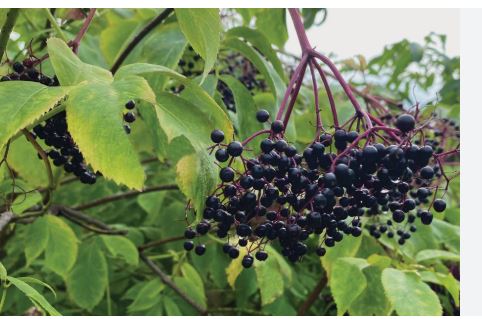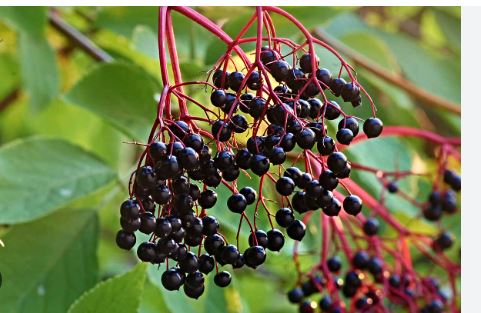
Elderberries are deciduous shrubs or small trees from the Sambucus genus, valued for their clusters of small, dark purple, black, or red berries and creamy white flowers. Native to temperate regions of Europe, North America, and Asia, they are grown for culinary, medicinal, and ornamental purposes. Their berries, when cooked, are used in jams, wines, and syrups, while flowers are brewed into cordials or teas.
These plants thrive in full sun to partial shade and moist, well-drained, slightly acidic soil (pH 5.5–6.5), adapting to USDA zones 3–9. They suit home gardens, orchards, or hedges, with heights ranging from 5–12 feet. Their adaptability to various soil types and climates makes them ideal for low-maintenance landscapes.
Elderberries bloom in early summer, producing flat-topped flower clusters that attract pollinators like bees and butterflies, followed by berries ripening in late summer to fall. Most require cross-pollination for optimal fruit production, though some are self-fruitful. Regular pruning encourages healthy growth and higher yields.
Berries and flowers are edible when cooked, but raw berries, leaves, stems, and roots are toxic due to cyanogenic glycosides, especially in red-berried types, which are generally inedible. Their high antioxidant content makes them popular for health-focused products like syrups or supplements. Ornamental types are prized for colorful foliage.
Challenges include toxicity risks, potential invasiveness in some regions, and susceptibility to pests like aphids. Proper cooking of berries and monitoring for spread are essential. Their culinary versatility, pollinator appeal, and ornamental value make elderberries a favorite for sustainable gardens.

Types of Elderberries
Adams
Adams is an American elderberry (Sambucus canadensis) cultivar (6–10 feet tall and wide) with large clusters of dark purple berries ripening in early September. Selected in New York, USA, it thrives in full sun to partial shade and moist, well-drained soil (pH 5.5–6.5) in USDA zones 3–9. Its vigorous growth and heavy fruit production suit home gardens for jellies, wines, or syrups, and it attracts pollinators like bees. Planting with another American variety enhances yields.
Johns
Johns is an American elderberry (Sambucus canadensis) cultivar (8–12 feet tall and wide) with large, sweet, dark purple berries ripening in late summer. Developed in Nova Scotia, Canada, it thrives in full sun and moist, fertile soil in zones 3–8. Its vigorous canes and high yields make it perfect for jellies, wines, or fritters from its flowers, and it suits large gardens or orchards. Planting with another variety improves fruit set.
Nova
Nova is an American elderberry (Sambucus canadensis) cultivar (5–6 feet tall and wide) with large, sweet, dark purple berries ripening in August. Bred in Nova Scotia, Canada, it thrives in full sun and well-drained, slightly acidic soil in zones 3–8. Its compact, self-fruitful nature suits smaller gardens or containers, though yields increase with a pollinator like Johns. Its flowers and berries are ideal for culinary uses like syrups or jams.
York
York is an American elderberry (Sambucus canadensis) cultivar (6–12 feet tall and wide) producing the largest dark purple berries among elderberries, ripening in late summer. Originating in New York, USA, it thrives in full sun to partial shade and moist, well-drained soil in zones 3–9. Its high yields suit culinary uses like pies or wines, and its flowers attract pollinators. Cross-pollination with Adams enhances fruit production.
Bob Gordon
Bob Gordon is an American elderberry (Sambucus canadensis) cultivar (6–8 feet tall and wide) with heavy clusters of sweet, dark purple berries ripening in late summer. Selected in Missouri, USA, it thrives in full sun and moist, well-drained soil in zones 3–9. Its decumbent berry clusters deter birds, making it ideal for high-yield harvests for syrups or jellies. It performs best with a pollinator like Wyldewood.
Wyldewood
Wyldewood is an American elderberry (Sambucus canadensis) cultivar (6–10 feet tall and wide) with prolific dark purple berries ripening late, often into fall. Selected in Oklahoma, USA, it thrives in full sun and moist, fertile soil in zones 3–9. Its indeterminate flowering suits extended harvests for preserves or wines, and its robust growth is ideal for orchards. Cross-pollination with Bob Gordon boosts yields.
Ranch
Ranch is an American elderberry (Sambucus canadensis) cultivar (5–6 feet tall and wide) with dark purple berries ripening early in summer. Originating in the USA, it thrives in full sun and poor or well-drained soils in zones 3–8. Its quick-rooting, upright stems suit small gardens or areas with marginal soil, and its berries are great for jellies. A pollinator like Nova enhances fruit set.
Black Lace
Black Lace is a European elderberry (Sambucus nigra) cultivar (6–8 feet tall and wide) with finely cut, dark purple foliage and pink, lemon-scented flowers, followed by black berries. Bred in Europe, it thrives in full sun to partial shade and moist, well-drained soil in zones 4–7. Its ornamental appeal suits landscaping, though berries are edible when cooked. It requires a pollinator like Black Beauty for fruit production.
Black Beauty
Black Beauty is a European elderberry (Sambucus nigra) cultivar (6–8 feet tall and wide) with deep purple foliage, pink flowers, and black berries. Developed in Europe, it thrives in full sun and moist, well-drained soil in zones 4–8. Its ornamental foliage and lemon-scented blooms make it ideal for hedges or focal points, with berries suitable for culinary use. Cross-pollination with Black Lace enhances yields.
Scotia
Scotia is an American elderberry (Sambucus canadensis) cultivar (5–6 feet tall and wide) with very sweet, dark purple berries ripening in late summer. Bred in Nova Scotia, Canada, it thrives in full sun and moist, fertile soil in zones 3–8. Its compact size and high sugar content suit small gardens and culinary uses like jams or wines. A pollinator like Johns improves fruit production.
Haschburg
Haschburg is a European elderberry (Sambucus nigra) cultivar (8–10 feet tall and wide) with large, juicy black berries and white flowers. Originating from Austria, it thrives in full sun to partial shade and moist, well-drained soil in zones 4–8. Its high yields and cold tolerance make it ideal for commercial production or home gardens for syrups or cordials. It requires a pollinator like Sampo.
Haidegg 17
Haidegg 17 is a European elderberry (Sambucus nigra) cultivar (8–10 feet tall and wide) with exceptionally large black berry clusters, yielding up to 25 tons per hectare. Bred in Klosterneuburg, Austria, it thrives in full sun and moist, well-drained soil in zones 4–8. Its rapid fruit production suits commercial or large gardens for preserves or wines. Cross-pollination with Haschburg ensures optimal yields.
Korsor
Korsor is a European elderberry (Sambucus nigra) cultivar (6–8 feet tall and wide) with high-sugar white flowers and black berries. Selected from the wild in Denmark, it thrives in full sun to partial shade and moist, well-drained soil in zones 4–8. Its sweet flowers are ideal for cordials, and berries suit culinary uses. It requires a pollinator like Allesso for fruit production.
Allesso
Allesso is a European elderberry (Sambucus nigra) cultivar (6–8 feet tall and wide) with sweet, black berries and white flowers high in sugar content. Selected from the wild in Denmark, it thrives in full sun and moist, well-drained soil in zones 4–8. Its flowers are prized for wines or cordials, and berries suit jellies. Cross-pollination with Korsor enhances fruit yields.
Bradet
Bradet is a European elderberry (Sambucus nigra) cultivar (6–8 feet tall and wide) with large, flavorful black berries bred for vitamin production. Developed in Romania in the 1950s, it thrives in full sun to partial shade and moist, well-drained soil in zones 4–8. Its high yields suit home or commercial gardens for syrups or medicinal uses. A pollinator like Haschburg boosts production.
Sutherland Gold
Sutherland Gold is a red elderberry (Sambucus racemosa) cultivar (2–3 meters tall) with golden-yellow, fern-like foliage and white flowers, followed by toxic red berries. Originating in Europe, it thrives in full sun to partial shade and well-drained soil in zones 3–7. Its ornamental foliage suits landscaping, not fruit production, and its compact size fits small gardens or borders. It is self-fertile but toxic, so avoid consumption